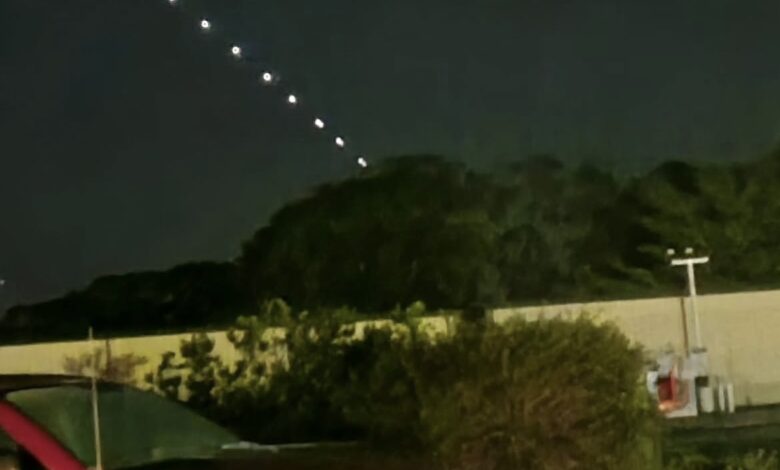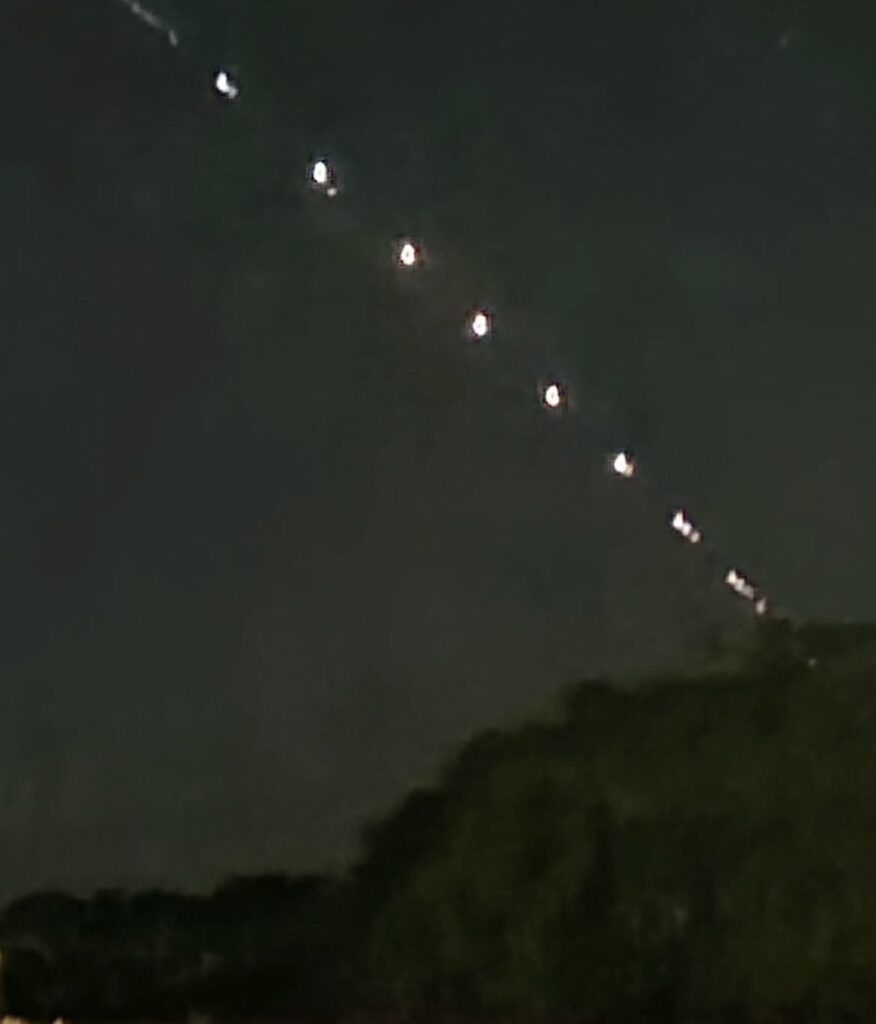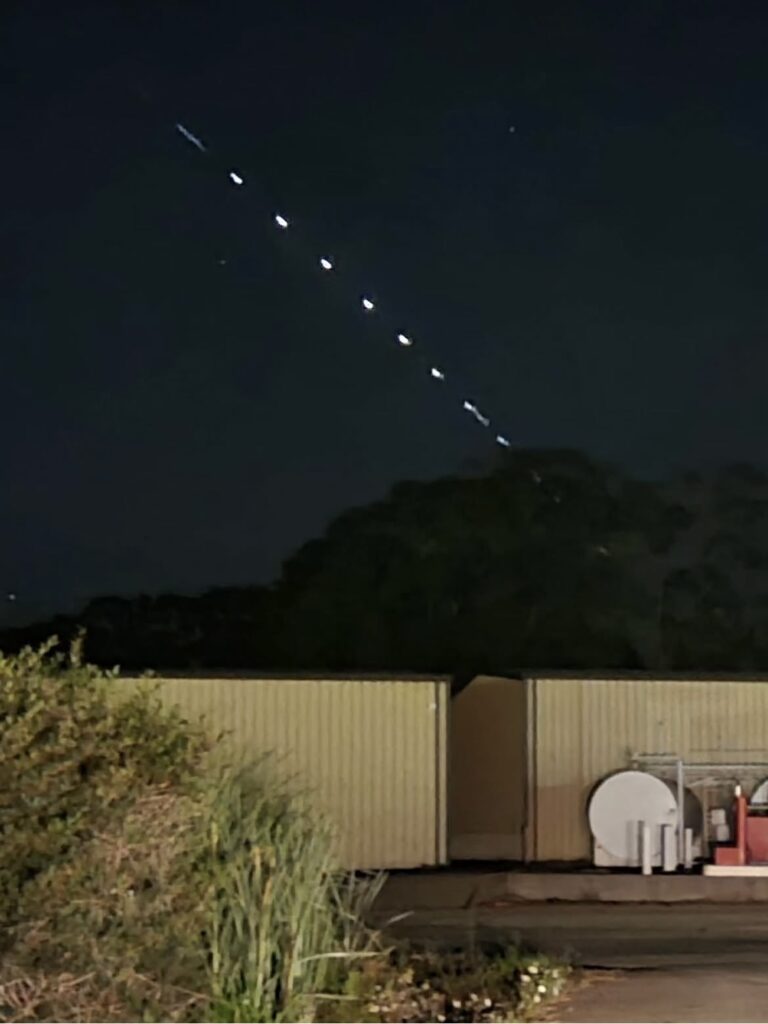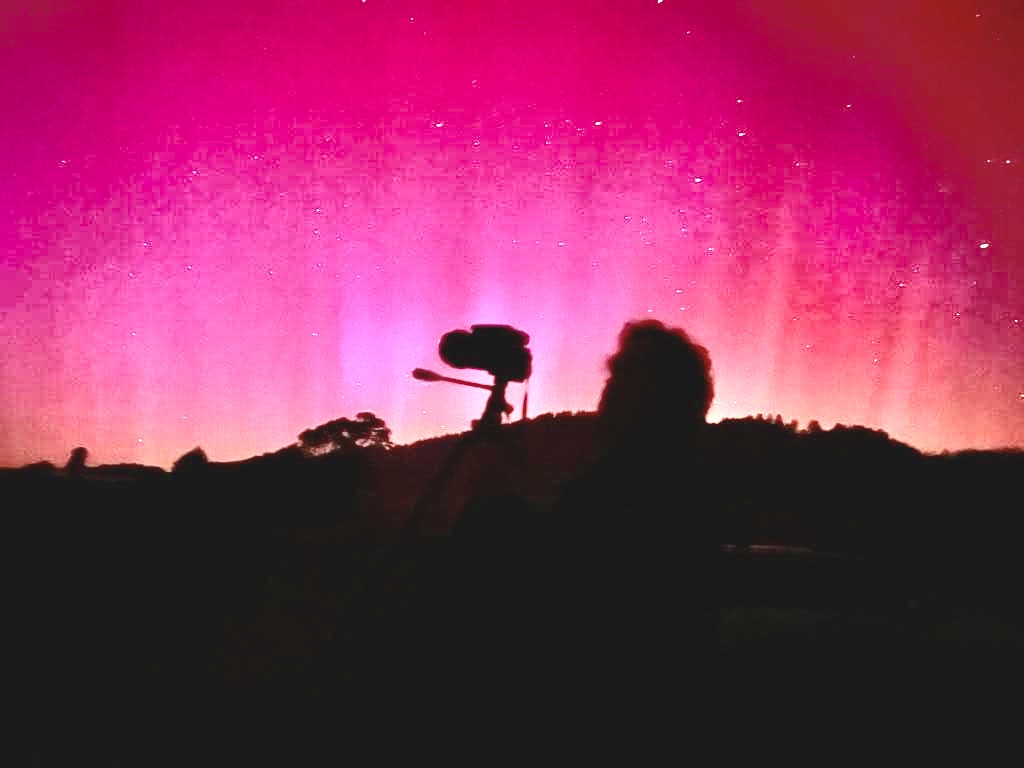Can you make a wish on a falling Starlink?—Wow!!!Did you see that?? Questions swirl about heavy metals overhead— and the risk of getting bonked by falling space junk

Plus- all Mendo Starbucks seem to have survived first round of closures-thanks Gary! And you other readers!
One of Elon Musk’s Starlink satellites exploded into a fiery spectacle Thursday night, sending glowing fragments streaking across the sky—a cosmic detonation that awed stargazers from Redding to Los Angeles. Mendocinocoast.news received six eyewitness reports from Mendocino County alone. So… what exactly did we just see?
We were midway through writing our own story when MendoFever beat us to the punch. At the time, we figured they’d covered it well enough—so we shared their link and moved on. But then our readers, especially Gary Levenson-Palmer, started digging deeper and helped us uncover the real story: what we saw blazing across the sky was a SpaceX Starlink internet/telecommunications satellite burning up as it reentered Earth’s atmosphere.
These satellites are designed to go out in a blaze of glory, disintegrating on a trajectory that ensures nothing but dust reaches the ground. But here’s the twist—thanks to increased solar activity, far more of them are falling than anyone planned. In one recent month alone, 40 newly launched Starlink satellites were hit with enough solar drag to destabilize their orbits. They went up, then came down, flaming out in spectacular fashion.
Solar Storm Impacting SpaceX Starlink
Here is nephew Joel Hartzell’s take on the INCREDIBLE Aurora we all saw in Fort Bragg in 2023
Another issue gaining attention is the sheer volume of satellites burning up and leaving behind metal residue in the atmosphere. As thousands of Starlink and other megaconstellation satellites reenter and disintegrate, they release aluminum and other heavy metals that weren’t part of Earth’s natural meteoroid mix. Scientists warn this artificial debris could alter the chemistry of the upper atmosphere, potentially contributing to ozone depletion. One recent study found that metals from reentering satellites are already present in 10% of the particles in the stratospheric sulfate layer—raising concerns that we may be conducting an accidental geoengineering experiment with unknown consequences
Gary and I had a blast chasing this story from our desktops. The best rabbit hole I fell into? Astrophysicist Jonathan McDowell, website, Jonathan’s Space Report, where he obsessively tracks satellite constellations. As of September 25, 2025, McDowell reports there are 8,475 Starlink satellites in orbit—8,460 of them considered operational. The eventual goal? A jaw-dropping 40,000 Starlink ships.
If you’re into space news and don’t mind a little nerd swagger, Jonathan’s your guy. He’s the long-haired superbrain who discovered the asteroid named after him back in 1994—Minor Planet McDowell. He also notes that SpaceX is responsible for the bulk of the traffic overhead, with roughly 15,000 satellites currently circling Earth.
His site dives into the latest SpaceX maneuvers, including the recent launch and orbital adventures of Northrop Grumman’s Cygnus NG-23 cargo ship—charmingly named the S.S. Willie McCool. For us lesser nerds of the night sky, it’s a double wow.
Jonathan’s Space Report also explains how satellites are designed to burn up safely at the end of their lives. Each one creates two meteors: the satellite itself and the rocket booster that got it there, which detaches and burns up almost immediately. Starlink ships are built to last about five years, but intense solar storms have been cutting careers short. The current solar maximum—Earth’s period of peak solar activity—is expected to wind down by the end of 2025, but not before it knocks a few more satellites out of the sky.


Gary dug up a great link that explains the dying Starlink satellite behind one of the most spectacular shows these flying machines have ever delivered.
Fireball in the sky over California identified as falling satellite – UPI.com
Many fall to Earth like the proverbial tree in the forest—unnoticed. If they reenter during daylight, early morning, or just don’t hit the drama jackpot, they skip the 700-mile light show and vanish without fanfare.
And yes, despite their design, these space machines can still pose risks. A 100-pound chunk of satellite debris landed on a Canadian farm last year, and a smaller piece crashed onto a North Carolina roof earlier this year.
So much for dust-only landings—turns out some of these space birds still pack a punch.
With little regulation on the number of satellites being launched, some worry space is becoming a junkyard—and that falling debris could one day injure or even kill someone. SpaceX calls it progress; critics call it orbital roulette.
SpaceX space junk crashed onto Saskatchewan farmland, highlighting a potential impending disaster
Mendo Starbucks survive cuts- for now..
Gary also tracked down the news that Starbucks apparently won’t be closing any Mendocino County locations. While the company has refused to release its full list of store closures until Sunday, some media sleuths found a workaround: employees at closing stores have been posting the news themselves. Then came the clever trick—outlets slated for closure show no operating hours starting Monday.
With 175 stores closing out of nearly 15,000 nationwide, combing through them manually is no small feat. But Gary did just that for the four Ukiah locations, the two in Willits, and the Fort Bragg Starbucks. All showed “open” for next week. That said, Starbucks has noted that some of the 175 closures will roll out over the coming months—so stay tuned, and maybe don’t buy that commemorative mug just yet.
For more background, check out our previous Mendocinocoast.news story on Starbucks.
While we reported the Starbucks news neutrally—and noted that the company offers better pay and benefits than fast food chains or Grocery Outlet—we were heartened to see many locals rallying around the idea of supporting small businesses if the Fort Bragg store were to close. After all, decisions like these are out of our hands, as they always are with corporate chains. They don’t consult the community. They don’t care whether we have a hospital, well-funded schools, or a livable quality of life. They crunch numbers, and if a town no longer “pencils,” they pack up and move on.
We believe the key to the future lies in building a resilient local economy—one rooted in real relationships, not corporate branding. That means getting along with neighbors who vote differently, and choosing local over the performative politics of Ben & Jerry’s lefty fakery (they’ve been owned by a global ag giant for years) or Hobby Lobby’s right-wing sermonizing. Forget the culture war mascots. Shop with your neighbors—whether you live in China, the USA, or anywhere in between.
The truth is, both countries are drifting toward modern feudalism. The U.S. is fast becoming a billionaire-run estate. China’s a capitalist-communist hybrid with more billionaires than any nation but ours—and soon to pass us. Let’s be clear: there’s no such thing as a billionaire in a communist country. What we’re seeing is feudalism, dressed up in different flags. In both systems, Main Street is crushed by Wall Street or the ruling elite.

And if you don’t agree with us, we’d love to hear your perspective. Share your ideas—and if you’ve got good reading on the subject, send it our way. We’re always up for a civil argument and a strong cup of coffee.
Because Main Street starts with you. Not with Amazon. Not with Wall Street. Not with billionaire feudalists in suits or satellites. It starts with neighbors choosing each other—over convenience, over algorithms, over corporate indifference.
So close your account at the chain bank. Move your money to Mendocino Savings Bank or the credit union. Skip the click-to-buy. Walk into a store. Talk to someone. Build something.
The future isn’t in the stars. It’s right here, in the hands of those who still care.

